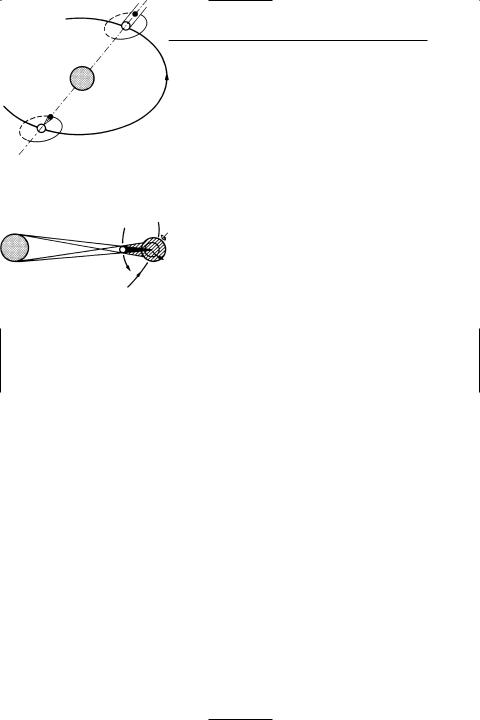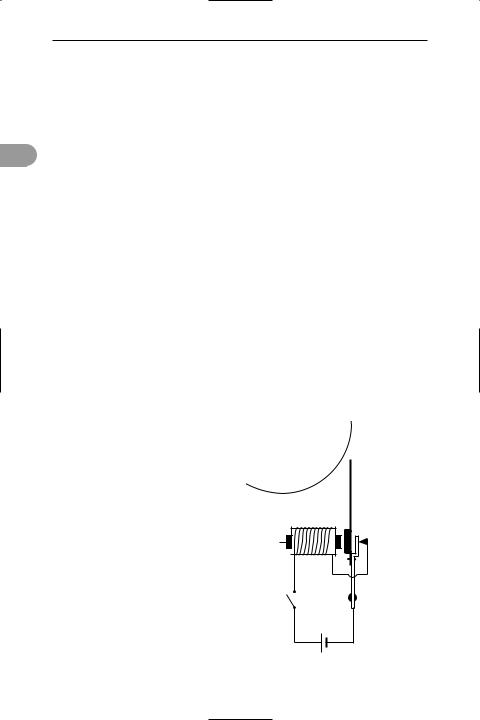
A Dictionary of Science
.pdf
ECM |
266 |
lunar eclipse
earth‘s orbit
esolar eclipse
Solar and lunar eclipses
moon‘s motion
path of
totality
earth‘s motion
Moon's shadow in solar eclipse
intersects the *celestial sphere. It is thus the sun’s apparent annual path across the sky.
ECM See extracellular matrix.
E. coli See escherichia coli.
ecological niche The status or role of an organism in its environment. An organism’s niche is deÜned by the types of food it consumes, its predators, temperature tolerances, etc. Two species cannot coexist stably if they occupy identical niches.
ecology The study of the interrelationships between organisms and their natural environment, both living and nonliving. For this purpose, ecologists study organisms in the context of the *populations and *communities in which they can be grouped and the *ecosystems of which they form a part. The study of ecological interactions provides important information on the nature and mechanisms of evolutionary change. Advances made in ecology over the last 25 years
have led to increased concern about the effects of human activities on the environment (notably the effects of *pollution), which has resulted in a greater awareness of the importance of *conservation.
ecosystem A biological *community and the physical environment associated with it. Nutrients pass between the different organisms in an ecosystem in deÜnite pathways; for example, nutrients in the soil are taken up by plants, which are then eaten by herbivores, which in turn may be eaten by carnivores (see food chain). Organisms are classiÜed on the basis of their position in an ecosystem into various *trophic levels. Nutrients and energy move round ecosystems in loops or cycles (in the case above, for example, nutrients are returned to the soil via animal wastes and decomposition). See carbon cycle; nitrogen cycle.
ectoderm The external layer of cells of the *gastrula, which will develop into the epidermis and the nervous system in the adult. See also germ layers.
ectoparasite A parasite that lives on the outside of its host’s body. See parasitism.
ectoplasm See cytoplasm.
Ectoprocta See bryozoa.
ectotherm (poikilotherm) An animal that maintains its body temperature by absorbing heat from the surrounding environment. All animals except mammals and birds are ectotherms; they are often described as being cold-blooded and are unable to regulate their body temperature metabolically. See poikilothermy. Compare
endotherm.
edaphic factor A factor relating to the physical or chemical composition of the soil found in a particular area. For example, very alkaline soil may be an edaphic factor limiting the variety of plants growing in a region.
Eddington limit A limit for the maximum value of the brightness of a star of a given mass. This limit exists because the radiation pressure caused by the nuclear fusion reactions powering the star has to counter, but not exceed, the gravitational force that would cause gravitational col-

267 |
egg |
lapse of the star. The existence of this limit was Ürst pointed out by the English astrophysicist Sir Arthur Stanley Eddington (1882–1944).
eddy current A current induced in a conductor situated in a changing magnetic Üeld or moving in a Üxed one. Any imagined circuit within the conductor will change its magnetic Ûux linkage, and the consequent induced e.m.f. will drive current around the circuit. In a substantial block of metal the resistance will be small and the current therefore large. Eddy currents occur in the cores of transformers and other electrical machines and represent a loss of useful energy (the eddy-current loss). To reduce this loss to a minimum metal cores are made of insulated sheets of metal, the resistance between these laminations reducing the current. In high-frequency circuits *ferrite cores can be used. Eddy currents in a moving conductor interact with the magnetic Üeld producing them to retard the motion of the conductor. This enables some electrical instruments (moving-coil type) to utilize eddy currents to create damping. Eddy currents are also used in *induction heating.
Edison cell See nickel–iron accumulator.
EDTA Ethylenediaminetetraacetic acid,
(HOOCCH2)2N(CH2)2N(CH2COOH)2
A compound that acts as a chelating agent, reversibly binding with iron, magnesium, and other metal ions. It is used in certain culture media bound with iron, which it slowly releases into the medium, and also in some forms of quantitative analysis.
EEG See electroencephalogram.
effective temperature See luminosity.
effective value See root-mean-square value.
effector A cell or organ that produces a physiological response when stimulated by a nerve impulse. Examples include muscles and glands.
effector neuron A nerve cell, such as a motor neuron, that transmits impulses
from the central nervous system to an *effector in order to bring about a physiological response to changes in the environment.
efferent Carrying (nerve impulses, blood, etc.) away from the centre of a body or organ towards peripheral regions. The term is usually applied to types of
nerve Übres or blood vessels. Compare af- e ferent.
effervescence The formation of gas bubbles in a liquid by chemical reaction.
efÜciency A measure of the performance of a machine, engine, etc., being the ratio of the energy or power it delivers to the energy or power fed to it. In general, the efÜciency of a machine varies with the conditions under which it operates and there is usually a load at which it operates with the highest efÜciency. The thermal efÜciency of a heat engine is the ratio of the work done by the engine to the heat supplied by the fuel. For a reversible heat engine this efÜciency equals (T1 – T2)/T1, where T1 is the thermodynamic temperature at which all the heat is taken up and T2 is the thermodynamic temperature at which it is given out (see carnot cycle). For real engines it is always less than this.
efÛorescence The process in which a crystalline hydrate loses water, forming a powdery deposit on the crystals.
effusion The Ûow of a gas through a small aperture. The relative rates at which gases effuse, under the same conditions, is approximately inversely proportional to the square roots of their densities.
egestion The expulsion from the body of waste food materials that have never left the gut, particularly the expulsion of undigested materials from the gut through the anus (see defecation). Egestion should not be confused with *excretion, in which the waste materials are produced by metabolic activity in the body’s tissues.
egg 1. The fertilized ovum (*zygote) in egg-laying animals, e.g. birds and insects, after it emerges from the body. The egg is covered by *egg membranes that protect it from environmental damage, such as

egg membrane |
268 |
drying. 2. (egg cell) The mature female reproductive cell in animals and plants.
See oosphere; ovum.
egg membrane The layer of material that covers an animal egg cell. Primary membranes develop in the ovary and cover the egg surface in addition to the normal plasma membrane. The primary
emembrane is called the vitelline membrane in insects, molluscs, birds, and am-
phibians, the chorion in tunicates and Üsh, and the zona pellucida in mammals. Insects have a second thicker membrane, also called the chorion. Secondary membranes are secreted by the oviducts and parts of the genital system while the egg is passing to the outside. They include the jelly coat of frogs’ eggs and the albumen and shell of birds’ eggs.
Ehrlich, Paul (1854–1915) German bacteriologist, who graduated as a physician in 1878. After working in a Berlin hospital for nine years he taught at Berlin University (unpaid because he was a Jew). In 1890 he went to work with Robert Koch (1843–1910) to study tuberculosis, cholera, and other diseases. In 1910 he discovered Salvarsan, an arsenical drug effective against syphilis. He was awarded the 1908 Nobel Prize for physiology or medicine for his earlier work on serum therapy.
eigenfunction An allowed *wave function of a system in quantum mechanics. The associated energies are eigenvalues.
Einstein, Albert (1879–1955) Germanborn US physicist, who took Swiss nation-
ality in 1901. A year later he went to work in the Bern patent ofÜce. In 1905 he published Üve enormously inÛuential papers, one on *Brownian movement, one on the *photoelectric effect, one on the special theory of *relativity, and one on energy and inertia (which included the famous expression E = mc2). In 1915 he published the general theory of relativity, concerned mainly with gravitation. In 1921 he was awarded the Nobel Prize. In 1933, as a Jew, Einstein decided to remain in the USA (where he was lecturing), as Hitler
had come to power. For the remainder of his life he sought a uniÜed Üeld theory. In 1939 he informed President Roosevelt that an atom bomb was feasible and that Germany might be able to make one.
Einstein coefÜcients CoefÜcients used in the *quantum theory of radiation, related to the probability of a transition occurring between the ground state and an excited state (or vice versa) in the processes of *induced emission and *spontaneous emission. For an atom exposed to *electromagnetic radiation, the rate of absorption Ra is given by Ra = Bρ, where ρ is the density of electromagnetic radiation and B is the Einstein B coefÜcient associated with absorption. The rate of induced emission is also given by Bρ, with the coefÜcient B of induced emission being equal to the coefÜcient of absorption. The rate of spontaneous emission is given by
A, where A is the Einstein A coefÜcient of spontaneous emission. The A and B coefÜcients are related by A = 8πhν3B/c3, where h is the *Planck constant, ν is the frequency of electromagnetic radiation, and c is the speed of light. The coefÜcients were put forward by Albert Einstein in 1916–17 in his analysis of the quantum theory of radiation.
Einstein equation 1. The mass–energy relationship announced by Einstein in 1905 in the form E = mc2, where E is a quantity of energy, m its mass, and c is the speed of light. It presents the concept that energy has mass. See also relativity.
2. The relationship
Emax = hf – W,
where Emax is the maximum kinetic energy of the electrons emitted in the photoemissive effect, h is the Planck constant, f the frequency of the incident radiation, and W the *work function of the emitter. This is also written Emax = hf – φe, where e is the electronic charge and φ a potential difference, also called the work function. (Sometimes W and φ are distinguished as work function energy and work function potential.) The equation can also be applied to photoemission from gases, when it has the form: E = hf – I, where I is the ionization potential of the gas.
einsteinium Symbol Es. A radioactive metallic transuranic element belonging to the *actinoids; a.n. 99; mass number of the most stable isotope 254 (half-life 270 days). Eleven isotopes are known. The element was Ürst identiÜed by Albert Ghiorso and associates in debris from the

269 |
elastomer |
Ürst hydrogen bomb explosion in 1952. Microgram quantities of the element did not become available until 1961.
Einstein shift See redshift.
ejaculation The propulsion of semen out of the erect penis due to powerful rhythmic contractions of the urethra. An ejaculation coincides with the peak of sexual excitement (orgasm) and is accompanied by various physiological effects in the body, such as increased respiration rate and heart rate.
ejecta Rocks and other material thrown up when a crater is formed. Some craters and their associated ejecta are volanic in origin, but most (especially on the moon, Mercury, and other planets and their satellites) are caused by the impact of meteorites. Often these are surrounded by an ejecta blanket, which is thickest near the crater’s rim.
Elasmobranchii See chondrichthyes.
elastance The reciprocal of *capacitance. It is measured in farad–1 (sometimes called a ‘daraf’).
elastic cartilage See cartilage.
elastic collision A collision in which the total kinetic energy of the colliding bodies after collision is equal to their total kinetic energy before collision. Elastic collisions occur only if there is no conversion of kinetic energy into other forms, as in the collision of atoms. In the case of macroscopic bodies this will not be the case as some of the energy will become heat. In a collision between polyatomic molecules, some kinetic energy may
be converted into vibrational and rotational energy of the molecules, but otherwise molecular collisions appear to be elastic.
elastic Übres See elastin.
elasticity The property of certain materials that enables them to return to their original dimensions after an applied *stress has been removed. In general, if a stress is applied to a wire, the *strain will increase in proportion (see OA on the illustration) until a certain point called the limit of proportionality is reached. This is in accordance with *Hooke’s law. There-
after there is at Ürst a slight increase in strain with increased load until a point L is reached. This is the elastic limit; up to this point the deformation of the specimen is elastic, i.e. when the stress is removed the specimen returns to its original length. Beyond the point L there is permanent deformation when the stress is removed, i.e. the material has
ceased to be elastic and has become plas- e tic. In the plastic stages individual ma-
terials vary somewhat; in general, however, at a point B there is a sudden increase in strain with further increases of stress – this is the yield point. Beyond the point C, the breaking stress, the wire will snap (which occurs at point D).
|
|
C |
|
load |
elastic limit |
breaking |
D |
L B |
|||
A |
stress |
|
|
|
yield point |
breaking |
|
|
proportional limit |
point |
|
|
|
|
|
Ostrain
Elasticity
elastic modulus The ratio of the
*stress applied to a body to the *strain produced. The Young modulus of elasticity, named after Thomas Young, refers to longitudinal stress and strain. The bulk modulus is the ratio of the pressure on a body to its fractional decrease in volume. The shear (or rigidity) modulus is the tangential force per unit area divided by the angular deformation in radians.
elastin A Übrous protein that is the major constituent of the yellow elastic Übres of *connective tissue. It is rich in glycine, alanine, proline, and other nonpolar amino acids that are cross-linked, making the protein relatively insoluble. Elastic Übres can stretch to several times their length and then return to their original size. Elastin is particularly abundant in elastic *cartilage, blood-vessel walls, ligaments, and the heart.
elastomer A natural or synthetic rubber or rubberoid material, which has the ability to undergo deformation

electret |
270 |
under the inÛuence of a force and regain its original shape once the force has been removed.
electret A permanently electriÜed substance or body that has opposite charges at its extremities. Electrets resemble permanent magnets in many ways. An electret can be made by cooling certain waxes
ein a strong electric Üeld.
electrical energy A form of energy re-
lated to the position of an electric charge in an electric Üeld. For a body with charge Q and an electric potential V, its electrical energy is QV. If V is a potential difference, the same expression gives the energy transformed when the charge moves through the p.d.
electric arc A luminous discharge between two electrodes. The discharge raises the electrodes to incandescence, the resulting thermal ionization largely providing the carriers to maintain the high current between the electrodes.
electric-arc furnace A furnace used in melting metals to make alloys, especially in steel manufacture, in which the heat source is an electric arc. In the direct-arc furnace, such as the Héroult furnace, an arc is formed between the metal and an electrode. In the indirect-arc furnace, such as the Stassano furnace, the arc is formed between two electrodes and the heat is radiated onto the metal.
electric bell A device in which an electromagnetically operated hammer strikes a bell (see illustration). Pressing the bell-
push closes a circuit, causing current to Ûow from a battery or mains step-down transformer through an electromagnet.
The electromagnet attracts a piece of soft iron attached to the hammer, which strikes the bell and at the same time breaks the circuit. The hammer springs back into its original position again, closing the circuit and causing the magnet to attract the soft iron. This process continues until the bell-push is released.
electric charge See charge. electric constant See permittivity. electric current See current. electric displacement (electric Ûux
density) Symbol D. The charge per unit area that would be displaced across a layer of conductor placed across an *electric Üeld. This describes also the charge density on an extended surface that could be causing the Üeld.
electric Üeld A region in which an electric charge experiences a force usually because of a distribution of other charges.
The electric Üeld strength or electric intensity (E) at any point in an electric Üeld is deÜned as the force per unit charge experienced by a small charge placed at that point. This is equivalent to a potential gradient along the Üeld and is measured in volts per metre. The strength of the Üeld can alternatively be described by its *electric displacement D. The ratio D/E for measurements in a vacuum is the electric constant ε0. In a substance the observed potential gradient is reduced by electron movement so that D/E appears to increase: the new ratio (ε) is called the *permittivity of the substance. An electric Üeld can be created by an isolated electric charge, in which case the Üeld strength at a distance r from a point charge Q is given by E = Q /4πr2ε, where ε is the permittivity of the intervening medium (see coulomb’s law). An electric Üeld can also be created by a changing magnetic Üeld.
bell
 hammer
hammer
light iron trembler
soft iron core 
coil
spring
switch
cell
Electric bell

271 |
electric potential |
electric Ûux Symbol Ψ. In an *electric Üeld, the product of the electric Ûux density and the relevant area. See electric displacement.
electric Ûux density See electric dis-
placement.
electricity Any effect resulting from the existence of stationary or moving electric charges.
electric lighting Illumination provided by electric currents. The devices used are the arc lamp, the light bulb (incandescent Ülament lamp), and the Ûuorescent tube. In the arc lamp, which is no longer used as a general means of illumination, an electric current Ûows through a gap between two carbon electrodes, between which a high potential difference is maintained. The current is carried by electrons and ions in the vapour produced by the electrodes and a mechanism is required to bring the electrodes closer together as they are vaporized. The device produces a strong white light but has many practical disadvantages. However, arcs enclosed in an inert gas (usually xenon) are increasingly used for such purposes as cinema projectors. The common light bulb is a glass bulb containing a tungsten Ülament and usually an inert gas. The passage of an electric current through the Ülament heats it to a white heat. Inert gas is used in the bulb to minimize blackening of the glass by evaporation of tungsten. In the Ûuorescent tube a glass tube containing mercury vapour (or some other gas) at a low pressure has its inner surface coated with a Ûuorescent substance. A discharge is created within the tube between two electrodes. Electrons emitted by the cathode collide with gas atoms or molecules and raise them to an excited state (see excitation). When they fall back to the *ground state they emit photons of ultraviolet radiation, which is converted to visible light by the coating of phosphor on the inner walls of the tube. In some lamps, such as the *sodium-vapour and *mercury-vapour lamps used in street lighting, no Ûuorescent substance is used, the light being emitted directly by the excited atoms of sodium or mercury. Vapour lights are more efÜcient than Ülament
lights as less of the energy is converted into heat.
electric motor A machine for converting electrical energy into mechanical energy. They are quiet, clean, and have a high efÜciency (75–95%). They work on the principle that a current passing through a coil within a magnetic Üeld will
experience forces that can be used to ro- e tate the coil. In the induction motor, alter-
nating current is fed to a stationary coil (the stator), which both creates the magnetic Üeld and induces a current in the rotating coil (rotor), which it surrounds. The advantage of this kind of motor is that current does not have to be fed through a commutator to a moving part. In the synchronous motor, alternating current fed to the stator produces a magnetic Üeld that rotates and locks with the Üeld of the rotor, in this case an independent magnet, causing the rotor to rotate at the same speed as the stator Üeld rotates. The rotor is either a permanent magnet or an electromagnet fed by a direct current through slip rings. In the universal motor, current is fed to the stator and, through a commutator, to the rotor. In the serieswound motor the two are in series; in the shunt-wound motor they are in parallel. These motors can be used with either a.c. or d.c. but some small motors use a permanent magnet as the stator and require d.c. for the rotor (via the commutator). See
also linear motor.
electric organ An organ occurring on the body or tail of certain Üsh, such as the electric ray (Torpedo) and electric eel (Electrophorus electricus). It gives an electric shock when touched and is used either to stun prey or predators or, in some species, to maintain a weak electric Üeld in the surrounding water that is used in navigation. The organ is composed of modiÜed muscle cells (electroplate cells), nervous stimulation of which greatly increases the potential difference across the cell. The electroplates are in series so a high overall voltage can be achieved.
electric polarization See dielectric.
electric potential Symbol V. The energy required to bring unit electric charge from inÜnity to the point in an electric Üeld at which the potential is being

electric power |
272 |
speciÜed. The unit of electric potential is the volt. The potential difference (p.d.) between two points in an electric Üeld or circuit is the difference in the values of the electric potentials at the two points, i.e. it is the work done in moving unit charge from one point to the other.
electric power The rate of expending
eenergy or doing work in an electrical system. For a direct-current circuit, it is given by the product of the current passing through a system and the potential differ-
ence across it. In alternating-current circuits, the power is given by VIcosφ, where V and I are the RMS values and φ is the *phase angle. Cosφ is called the power factor of the circuit.
electric spark The transient passage of an electric current through a gas between two points of high opposite potential, with the emission of light and sound. *Lightning consists of a spark between a cloud and earth or between two oppositely charged parts of the same cloud.
electric susceptibility See susceptibility.
electrocardiogram (ECG) A tracing or graph of the electrical activity of the heart. Recordings are made from electrodes fastened over the heart and usually on both arms and a leg. Changes in the normal pattern of an ECG may indicate heart irregularities or disease.
electrochemical cell See cell.
electrochemical equivalent Symbol z. The mass of a given element liberated from a solution of its ions in electrolysis by one coulomb of charge. See faraday’s laws (of electrolysis).
electrochemical series See electromotive series.
electrochemistry The study of chemical properties and reactions involving ions in solution, including electrolysis and electric cells.
electrochromatography See electrophoresis.
electrode 1. A conductor that emits or collects electrons in a cell, thermionic valve, semiconductor device, etc. The anode is the positive electrode and the
cathode is the negative electrode. 2. See half cell.
electrodeposition The process of depositing one metal on another by electrolysis, as in *electroforming and *electroplating.
electrode potential The potential difference produced between the electrode and the solution in a *half cell. It is not possible to measure this directly since any measurement involves completing the circuit with the electrolyte, thereby introducing another half cell. Standard electrode potentials EŠ are deÜned by measuring the potential relative to a standard *hydrogen half cell using 1.0 molar solution at 25°C. The convention is to designate the cell so that the oxidized form is written Ürst. For example,
Pt(s)|H2(g)H+(aq)|Zn2+(aq)|Zn(s)
The e.m.f. of this cell is –0.76 volt (i.e. the zinc electrode is negative). Thus the standard electrode potential of the Zn2+|Zn half cell is –0.76 V. Electrode potentials are also called reduction potentials. See also electromotive series.
electrodialysis A method of obtaining pure water from water containing a salt, as in *desalination. The water to be puriÜed is fed into a cell containing two electrodes. Between the electrodes is placed an array of *semipermeable membranes alternately semipermeable to positive ions and negative ions. The ions tend to segregate between alternate pairs of membranes, leaving pure water in the other gaps between membranes. In this way, the feed water is separated into two streams: one of pure water and the other of more concentrated solution.
electrodynamics The study of electric charges in motion, the forces created by electric and magnetic Üelds, and the relationship between them. Compare electrostatics.
electroencephalogram (EEG) A tracing or graph of the electrical activity of the brain. Electrodes taped to the scalp record electrical waves from different parts of the brain. The pattern of an EEG reÛects an individual’s level of consciousness and can be used to detect such disor-

273 |
electromagnetic induction |
ders as epilepsy, tumours, or brain damage. See also brain death.
electroforming A method of forming intricate metal articles or parts by *electrodeposition of the metal on a removable conductive mould.
electroluminescence See luminescence.
electrolysis The production of a chemical reaction by passing an electric current through an electrolyte. In electrolysis, positive ions migrate to the cathode and negative ions to the anode. The reactions occurring depend on electron transfer at the electrodes and are therefore redox reactions. At the anode, negative ions in solution may lose electrons to form neutral species. Alternatively, atoms of the electrode can lose electrons and go into solution as positive ions. In either case the reaction is an oxidation. At the cathode, positive ions in solution can gain electrons to form neutral species. Thus cathode reactions are reductions.
electrolyte A liquid that conducts electricity as a result of the presence of positive or negative ions. Electrolytes are molten ionic compounds or solutions containing ions, i.e. solutions of ionic salts or of compounds that ionize in solution. Liquid metals, in which the conduction is by free electrons, are not usually regarded as electrolytes. Solid conductors of ions, as in the sodium–sulphur cell, are also known as electrolytes.
electrolytic capacitor See capacitor.
electrolytic cell A cell in which electrolysis occurs; i.e. one in which current is passed through the electrolyte from an external source.
electrolytic corrosion Corrosion that occurs through an electrochemical reaction. See rusting.
electrolytic gas (detonating gas) The highly explosive gas formed by the electrolysis of water. It consists of two parts hydrogen and one part oxygen by volume.
electrolytic rectiÜer A *rectiÜer consisting of two dissimilar electrodes immersed in an electrolyte. By suitable choice of electrodes and electrolyte the
cell can be made to pass current easily in one direction but hardly at all in the other. Examples include a lead– aluminium cell with ammonium phosphate(V) electrolyte and a tantalum–lead
cell with sulphuric acid as the electrolyte.
electrolytic reÜning The puriÜcation of metals by electrolysis. It is commonly
applied to copper. A large piece of impure e copper is used as the anode with a thin
strip of pure copper as the cathode. Copper(II) sulphate solution is the electrolyte. Copper dissolves at the anode: Cu → Cu2+ + 2e, and is deposited at the cathode. The net result is transfer of pure copper from anode to cathode. Gold and silver in the impure copper form a so-called anode sludge at the bottom of the cell, which is recovered.
electrolytic separation A method of separating isotopes by exploiting the different rates at which they are released in electrolysis. It was formerly used for separating deuterium and hydrogen. On electrolysis of water, hydrogen is formed at the cathode more readily than deuterium, thus the water becomes enriched with deuterium oxide.
electromagnet A magnet consisting of a soft ferromagnetic core with a coil of insulated wire wound round it. When a current Ûows through the wire the core becomes magnetized; when the current ceases to Ûow the core loses its magnetization. Electromagnets are used in switches, solenoids, electric bells, metal-lifting cranes, and many other applications.
electromagnetic induction The production of an electromotive force in a conductor when there is a change of magnetic Ûux linkage with the conductor or when there is relative motion of the conductor across a magnetic Üeld. The magnitude of the e.m.f. is proportional (and in modern systems of units equal) to the rate of change of the Ûux linkage or the rate of cutting Ûux dΦ/dt; the sense of the induced e.m.f. is such that any induced current opposes the change causing the induction, i.e. E = –dΦ/dt. See faraday’s laws; lenz’s law; neumann’s law; inductance.

electromagnetic interaction |
274 |
electromagnetic interaction See fundamental interactions.
electromagnetic pump A pump used for moving liquid metals, such as the liq- uid-sodium coolant in a fast nuclear reactor. The liquid is passed through a Ûattened pipe over two electrodes between which a direct current Ûows. A
emagnetic Üeld at right angles to the current causes a force to be created directly on the liquid, along the axis of the tube. The pump has no moving parts and is therefore safe and trouble free.
electromagnetic radiation Energy re-
sulting from the acceleration of electric charge and the associated electric Üelds and magnetic Üelds. The energy can be regarded as waves propagated through space (requiring no supporting medium)
involving oscillating electric and magnetic Üelds at right angles to each other and to the direction of propagation. In a vacuum
the waves travel with a constant speed (the speed of light) of 2.9979 × 108 metres per second; if material is present they are slower. Alternatively, the energy can be regarded as a stream of *photons travel-
ling at the speed of light, each photon having an energy hc/λ, where h is the
Planck constant, c is the speed of light, and λ is the wavelength of the associated
wave. A fusion of these apparently conÛicting concepts is possible using the methods of *quantum mechanics or *wave mechanics. The characteristics of the radiation depend on its wavelength.
See electromagnetic spectrum.
electromagnetic spectrum The range of wavelengths over which *electromagnetic radiation extends. The longest waves (105–10–3 metres) are radio waves, the next longest (10–3–10–6 m) are infrared
waves, then comes the narrow band
(4–7 × 10–7 m) of visible light, followed by ultraviolet waves (10–7–10–9 m), X-rays (10–9–10–11 m), and gamma rays (10–11– 10–14 m).
electromagnetic units (e.m.u.) A system of electrical units formerly used in the *c.g.s. system. The e.m.u. of electric
current is the abampere (all e.m.u. have the preÜx ab- attached to the names of
practical units). The abampere is the current that, Ûowing in an arc of a circle
(1 centimetre in diameter), exerts a force of 1 dyne on unit magnetic pole at the centre of the circle. In e.m.u. the magnetic constant is of unit magnitude. The system has now been replaced by *SI units for most purposes. Compare electrostatic units; gaussian units; heaviside– lorentz units.
electromagnetic wave See electromagnetic radiation; wave.
electrometallurgy The uses of electrical processes in the separation of metals from their ores, the reÜning of metals, or the forming or plating of metals.
electrometer A measuring instrument for determining a voltage difference without drawing an appreciable current from the source. Originally electrostatic instruments based on the electroscope, they are now usually based on operational ampliÜers, solid-state devices with high input impedances. Electrometers are also used to measure low currents (nanoamperes), by passing the current through a high resistance.
electromotive force (e.m.f.) The greatest potential difference that can be generated by a particular source of electric current. In practice this may be observable only when the source is not supplying current, because of its *internal resistance.
electromotive series (electrochemical series) A series of chemical elements arranged in order of their *electrode potentials. The hydrogen electrode (H+ + e → ½H2) is taken as having zero electrode potential. Elements that have a greater tendency than hydrogen to lose electrons to their solution are taken as electropositive; those that gain electrons from their solution are below hydrogen in the series and are called electronegative. The series shows the order in which metals replace one another from their salts; electropositive metals will replace hydrogen from acids. The chief metals and hydrogen, placed in order in the series, are: potassium, calcium, sodium, magnesium, aluminium, zinc, cadmium, iron, nickel, tin, lead, hydrogen, copper, mercury, silver, platinum, gold. This type of series is sometimes referred to as an activity series.

275 |
electronegative |
electron An *elementary particle, classed as a *lepton, with a rest mass (symbol me) of 9.109 3897(54) × 10–31 kg and a negative charge of 1.602 177 33(49) × 10–19 coulomb. Electrons are present in all atoms in groupings called shells around the nucleus; when they are detached from the atom they are called free electrons. The antiparticle of the electron is the positron.
electron afÜnity Symbol A. The energy change occurring when an atom or molecule gains an electron to form a negative ion. For an atom or molecule X, it is
the energy released for the electronattachment reaction
X(g) + e → X–(g)
Often this is measured in electronvolts. Alternatively, the molar enthalpy change, ∆H, can be used.
electron biprism An arrangement of
Üelds that splits a beam of electrons or other charged particles in an analogous way to an optical biprism.
electron capture 1. The formation of a negative ion by an atom or molecule when it acquires an extra free electron. 2. A radioactive transformation in which a nucleus acquires an electron from an inner orbit of the atom, thereby transforming, initially, into a nucleus with the
same mass number but an atomic number one less than that of the original nucleus (capture of the electron transforms a proton into a neutron). This type of capture is accompanied by emission of an X-ray photon or Auger electron as the vacancy in the inner orbit is Ülled by an outer electron.
electron-deÜcient compound A compound in which there are fewer electrons forming the chemical bonds than required in normal electron-pair bonds. Such compounds use *multicentre bonds.
See borane.
electron diffraction *Diffraction of a beam of electrons by atoms or molecules. The fact that electrons can be diffracted in a similar way to light and X-rays shows that particles can act as waves (see de broglie wavelength). An electron (mass m, charge e) accelerated through a poten-
tial difference V acquires a kinetic energy mv2/2 = eV, where v is the velocity of the electron. The (nonrelativistic) momentum (p) of the electron is √(2eVm). The de Broglie wavelength (λ) of an electron is given by h/p, where h is the Planck constant, thus λ = h/√(2eVm). For an accelerating voltage of 3600 V, the wavelength of the electron beam is 0.02 nanometre,
some 3 × 104 times shorter than visible ra- e diation.
Electrons then, like X-rays, show diffraction effects with molecules and crystals in which the interatomic spacing is comparable to the wavelength of the beam. They have the advantage that their wavelength can be set by adjusting the voltage. Unlike X-rays they have very low penetrating power. The Ürst observation of electron diffraction was by George Thomson (1892–1975) in 1927, in an experiment in which he passed a beam of electrons in a vacuum through a very thin gold foil onto a photographic plate. Concentric circles were produced by diffraction of electrons by the lattice. The same year Clinton J. Davisson (1881–1958) and Lester Germer (1896–1971) performed a classic experiment in which they obtained diffraction patterns by glancing an electron beam off the surface of a nickel crystal. Both experiments were important veriÜcations of de Broglie’s theory and the new quantum theory.
Electron diffraction, because of the low penetration, cannot easily be used to investigate crystal structure. It is, however, employed to measure bond lengths and angles of molecules in gases. Moreover, it is extensively used in the study of solid surfaces and absorption. The main techniques are low-energy electron diffraction (LEED) in which the electron beam is reÛected onto a Ûuorescent screen, and high-energy electron diffraction (HEED) used either with reÛection or transmission in investigating thin Ülms.
electronegative Describing elements that tend to gain electrons and form negative ions. The halogens are typical electronegative elements. For example, in hydrogen chloride, the chlorine atom is more electronegative than the hydrogen and the molecule is polar, with negative charge on the chlorine atom. There are
